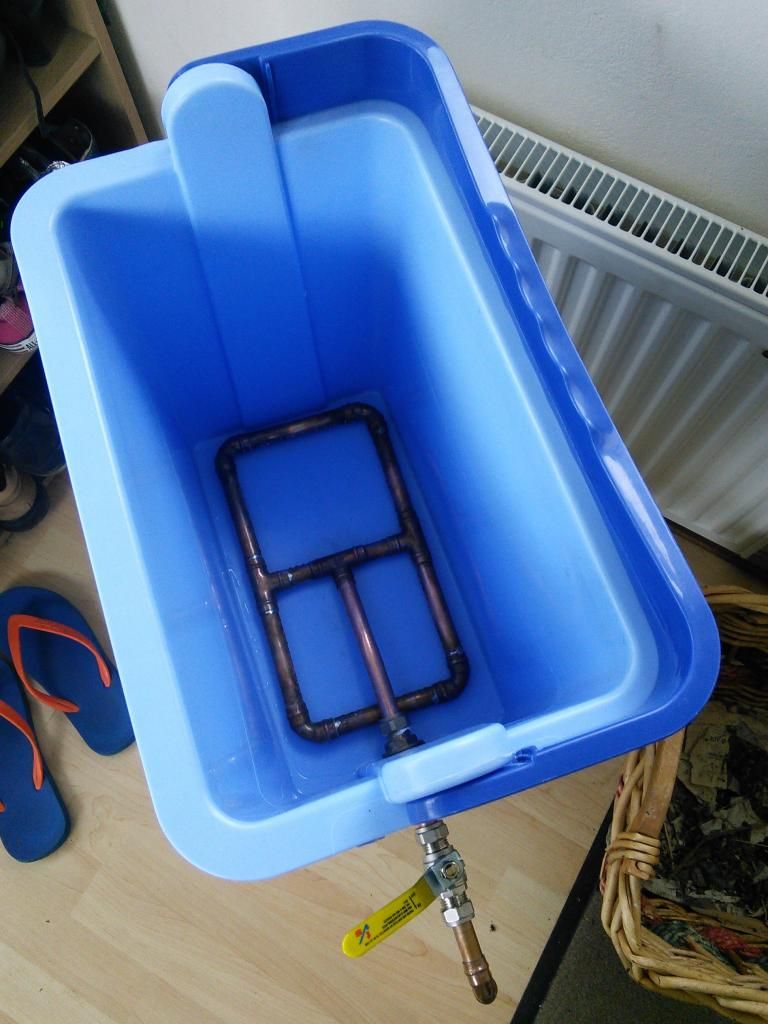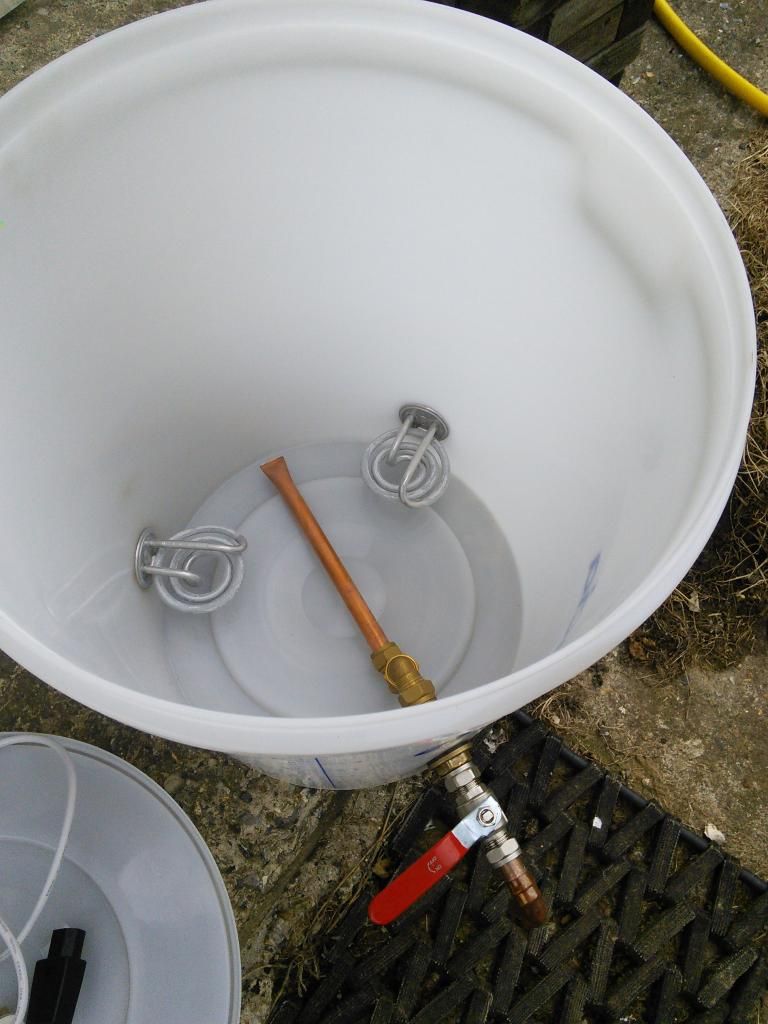33L boiler build, what size and shape mash run?
-
FarmerFred
Re: 33L boiler build, what size and shape mash run?
Hi Rick, glad to hear you had success with your MT especially once grain added. I've had an evening in the shed knocking up the copper pipework for draining. I ended up putting a tank connector on inner skin with a rubber seal on both sides nipped up and half a connector on outside to hold the pipe through. Just need a bit of hose to connect the drain to the tap pipe and I'm away. But then there's the wort cooler...
-
YeastWhisperer
Re: 33L boiler build, what size and shape mash run?
The beauty of a well-engineered cooler (coolbox) is that it will hold temperature for a long time. My current industrial Igloo beverage cooler-based mash/lauter tun will hold the mash to within 1 degree C over a ninety minute period if I do not remove the lid.FarmerFred wrote:Think you could be right Fil. Thinki can live with 2c drop while I'm just experimenting and finding my AG feet.
I thought batch sparging would perhaps be more forgiving Yeastwhisperer. Perhaps in the future it would be something to aspire to but right now I'm focusing on basics.
I'm not sure if we have such a glut of coolers and I think 50-60l is as big as they get here. Building sites would probably worry more about the kettle here in blighty than a cooler!!
If I was not approaching the curmudgeon stage in life, I would more than likely switch to batch sparging. I stick with continuous sparging because I know how to do it well. Plus, it is really hard to achieve an extraction rate much above 29 points per pound per U.S. gallon (242 points per kilogram per liter or an efficiency of 78.4%) with batch sparging. There are guys who are able to exceed this threshold. However, there's as much technique involved with making that jump in efficiency as there is with continuous sparging, and continuous sparging is less work.
You guys have the advantage of having 220VAC as your standard mains voltage, which makes electric brewing simple. Our homes are supplied with 240VAC, but this voltage source is split into two 120 VAC voltage sources except for on a few appliance and high wattage electrical device circuits. I am thinking about having an electrician run a 240VAC circuit out to my garage. I want to switch to using a 3K to 5K Watt induction stove, so that I can shut my garage door during the winter.
-
YeastWhisperer
Re: 33L boiler build, what size and shape mash run?
Unlike most American amateur brewers, I prefer to use a Camp Chef SB30D Pro 30 30K BTU low pressure stove, which is sensitive to the wind. I can get 10 to 12 batches out of a 20lb propane cylinder using this stove. The typical high-pressure stoves that are used by American amateur brewers burn through a 20lb cylinder in 4 to 6 batches.FarmerFred wrote:Doesn't your gas burner keep your garage nice and warm though in winter??
Camp Chef SB30D Pro 30

Moving to an induction stove will give be me the benefit of even heating with the low-cost operation and relative safety of electric operation. My garage is attached to my house. I prefer to stay in my house while the wort is boiling, which leaves a 30K BTU propane stove unattended. I used to boil in the rear basement stairwell of my old house because it did not have a garage. There was no risk of carbon monoxide poisoning with that setup. Most of the large propane stoves that are designed for outdoors operation do not burn with a perfectly blue flame, which means that they are emitting carbon monoxide.
That's a nice job, but it is complete overkill for batch sparging. The beauty of batch sparging is that it is not dependent on even fluid flow through the entire mash bed, which means that one can crush the living daylights out one's malt. The best thing to use as a mash filter when batch sparging is a length of the stainless steel braid that is used to reinforce rubber hoses. This braid allows one crush one's malt very fine because it does not rely on large pieces of intact husk material to filter the mash.Well here is the finished mash tun. My first foray into plumbing.
Here's a photo of the inside Denny Conn's cooler-based mash tun. Denny is the undisputed king of batch sparging. This guy is the definition of the word "pragmatic."

Denny's Web Page
http://www.dennybrew.com/
I was absolutely amazed the first time that I saw a bucket-based boiler on a British brewing website. Electric brewing did not become popular here in the U.S. until the late 00s. As mentioned earlier, most American houses are not set up for electric brewing. The standard American electrical branch circuit is limited to 15A of current at 120VAC, which means that the maximum wattage obtainable is 1800W.And here is the boiler.
-
Fil
- Telling imaginary friend stories
- Posts: 5229
- Joined: Sun Oct 16, 2011 1:49 pm
- Location: Cowley, Oxford
Re: 33L boiler build, what size and shape mash run?
think i was equally amazed when the web showed me pics of US diy brewkits, fabricated from kegs all shiny n bright.. as an aspiring kit brewer in the 70's i had an old paperback brew book by a chap more known for his country wines detailing an ag brewkit made from buckets and a burco boiler.. (i found a copy on amazon and had to buy it for nostalgia sake) - and yes it does suggest plastic dustbins (garbage cans) suitable FV's Or a metal one lined with a black bag!!???? my times have changed..I was absolutely amazed the first time that I saw a bucket-based boiler on a British brewing website. Electric brewing did not become popular here in the U.S. until the late 00s.
seems to me that home brewing in the states is more a suburban pastime where here in the UK its well centred in what the americans would call the projects.
also we have a dependable electric supply in the UK, think the last time we had a hiccup in supply was about 8years ago and only lasted 20 mins or so.. in fact it was longer ago than that as iirc it interrupted the showing of the last episode of buffy the vampire slayer (letch letch)..
-
YeastWhisperer
Re: 33L boiler build, what size and shape mash run?
Brewing is primarily a suburban/exurban/rural pastime in the U.S. due to the fact it is difficult to brew all-grain beer in an apartment (a.k.a. flat). Up until very recently, brewing batches much larger than a gallon or two required the use of a propane stove that is designed for cooking outdoors, which is either unlawful to use or a violation of one's lease to use in an apartment (a.k.a flat). There are many city-based brewers who live in row homes, which, in the states, are non-free standing city houses. One of the oldest home brewing clubs in Maryland is based in Baltimore City.Fil wrote:seems to me that home brewing in the states is more a suburban pastime where here in the UK its well centred in what the americans would call the projects.
With respect to converting kegs to kettles, well, you will not find a more controversial subject within the amateur brewing community. Keg theft is a big problem in the states. Many Americans falsely assume that a keg deposit conveys ownership. The deposit that one places on a keg when purchasing draught beer does not entitle him/her to keep it. Kegs remain the property of the brewery whose name they bear throughout the three-tier system. Keg deposits are basically good faith refundable rental fees. The price of replacement is significantly higher than the deposit in most states. Due to the three-tier distribution system that was put into place after Prohibition, breweries are not allowed to set keg deposits (If they were allowed to set keg deposits, they would be more like $150.00 than $25-$50). The states usually set keg deposits. In fact, breweries were not allowed to sell beer directly to consumers until very recently. Breweries sold to distributors who sold to retailers who sold to customers. There are companies such as Anheuser-Busch who strictly forbid the scrap yards with whom they conduct business from reselling their kegs; therefore, any keggle (keg-based kettle) that you see on the Internet that bears the name Anheuser-Busch can be assumed to be stolen property.
With that said, I hate keggles. They are not designed with boiling in mind. Their only saving grace is that one can steal one for the price of a deposit. I would much rather have a stockpot-based kettle. Stockpots are designed for boiling liquid, not serving beer. The reason why keggles became popular in the first place is because it used to be difficult to acquire large restaurant-grade stainless steel stockpots. The suppliers of large restaurant-grade stockpots only sold to the trade. The Internet fixed that problem.



